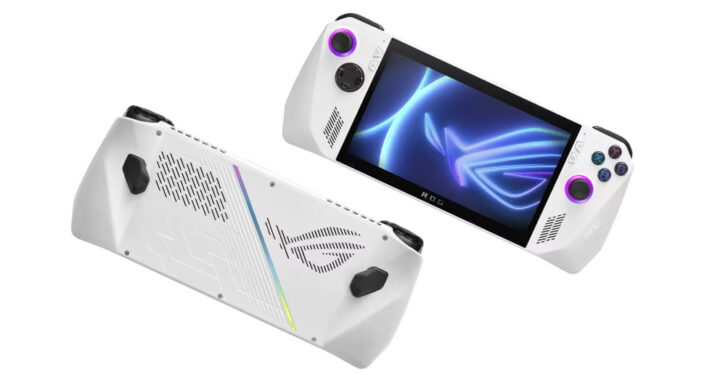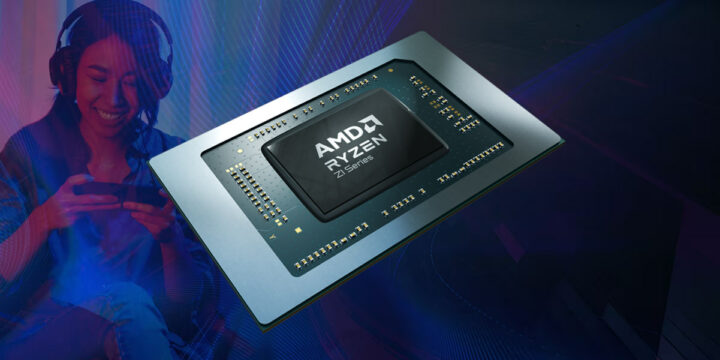AMD has just unveiled the new power-efficient Ryzen Z1 “Zen4” Series processor family designed for handheld gaming consoles running Windows and equipped with AMD RDNA 3 architecture-based graphics.
The new series features two processors at launch, namely the Ryzen Z1 hexa-core processor with 4 RDNA 3 Compute Units and the Ryzen Z1 Extreme octa-core processor with 12 RDNA 3 Computer Units for “ultimate high-performance for handheld gaming”.
Highlights of Ryzen Z1 and Z1 extreme specifications:
AMD Ryzen Z1 | AMD Ryzen Z1 Extreme |
|
|---|---|---|
| # of CPU Cores | 6 | 8 |
| # of Threads | 12 | 16 |
| L2 Cache | 6MB | 8MB |
| L3 Cache | 16MB |
|
| AMD Configurable TDP (cTDP) | 15-30W |
|
| Graphics Core Count | 4 | 12 |
Both processors support LPDDR5/LPDDR5x memory, and USB4 interface, as well as the following AMD technologies:
- AMD Link – Mobile app to connect your phone, tablet, TV, or Windows-based PC, and stream games.
- AMD Radeon Super Resolution – In-driver feature upscaling lower resolutions set in-game to the native resolution of the active display for higher FPS performance.
- AMD Radeon Boost – Dynamically lowers the resolution of the entire frame when fast on-screen character motion is detected via user input, allowing for higher FPS.
- AMD Radeon Anti-Lag – Reduce input lag in GPU-limited cases.
- AMD FreeSync Technology – Enables variable refresh rate aimed at avoiding tearing and reducing stuttering caused by a misalignment between the screen’s refresh rate and the content’s frame rate
- AMD Radeon Chill – Dynamically regulates framerate based on in-game movements & provides power savings that reduce GPU temperatures.

While the press release claims compatibility with Windows 11 and other operating systems, it appears the Ryzen Z1 Series processors are optimized for Windows 11, and AMD highlights support for Xbox Game Pass Ultimate (sold separately) to access hundreds of PC games on Ryzen Z1 handheld devices. So it’s unclear whether any efforts will be made to have Linux running on the new processor, at least from AMD themselves.
Asus ROG Ally portable game console will be one of the first devices powered by the AMD Ryzen Z1 Extreme processor with availability and pricing information to be announced by Asus on May 11. More details about the new processors can be found on the product page.

Jean-Luc started CNX Software in 2010 as a part-time endeavor, before quitting his job as a software engineering manager, and starting to write daily news, and reviews full time later in 2011.
Support CNX Software! Donate via cryptocurrencies, become a Patron on Patreon, or purchase goods on Amazon or Aliexpress






For a “custom” APU, the Z1 Extreme seems identical to the 7940HS/U. Then the 6-core Z1 gets a 2/3 cut on graphics, as if that makes any sense.
Asus will be able to charge a lot for the 8-core, not sure about the 6-core if that’s slower than the Steam Deck.
If it’s a Zen4 core, then it may be faster than the Steam Deck even with fewer cores. It’s certain to be more power efficient. Throw in the high speed LPDDR5x memory and it should do really well.
If I had any use for one of these devices, I’d be very excited by this, but the games I play are either way too heavy for this or are Keyboard/Mouse games that just don’t work with buttons and d-pads or even analog sticks/pads.
I’m sure the CPU performance will be excellent. But it’s 4 CU RDNA3 vs. 8 CU RDNA2 (Steam Deck). Maybe emulation will be where it gets the edge, especially since some of them can use AVX-512.
Fewer CUs, but more capable ones and higher clocking will pose a tradeoff. Add in the higher memory BW and that should help.
>For a “custom” APU, the Z1 Extreme seems identical to the 7940HS/U.
The Z1 is just a 7940 tuned for low voltage / wattage.
Making it “customized”. it seems to be somewhere in-between a U and an H-model. Tdp of a U model with H-model cores
6,8 cores for games?
Yes? What’s your question here? Most modern games can use that many cores no problem.
Xbox Series X/S and PS5 use 8 cores, so that’s going to be the gaming standard for the rest of the decade.
It’s also worth noting that 8 CPU cores are tiny on recent process nodes, to the point where we will likely see 12-16 cores in AMD’s mobile CPUs soon.